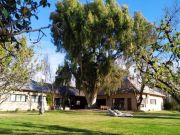Middle Valley: endpoint to an exodus of 400 years See map
Middle Valley is a cultural "bricollage". In this region of Río Negro live the most diverse communities: "Orthodox Old Believers" of the Russian mainland, "Hmoob" (Indochina), "Prussian German" Germans of Jewish origin, a very strong Bolivian colony dedicated to horticulture, a historic Welsh migration. All this diversity on the basis of the classic Italian, lebanese and spanish immigrants, colonizers that make the genius of this segment of the Negro river (about 200 kilometers). In the background a Creole population that reaches even to keep some of their indigenous roots.
The "Orthodox Old Believers"
Known locally as "White Russians" are showing, despite being seated for three decades in this region, all the color of their traditions in dress, beliefs, language and lifestyle.
Russian jackets and beards for men, forced to cover the hair and hit long skirt in bright colors to the world of women is something that no member of this community has resigned.
Settled almost exclusively in rural areas, about 20 families of "White Russians" maintain their original "peasant" way of life, many of them living a subsistence economy. As an exception quickly adapted one western element, provided that economic conditions allow it, move in vehicles without limiting gender (sex) to command the steering wheel.
As they came to these lands is a history that goes back to an exodus of about 400 years ago. It was the last decades of the seventeenth century, when these Slavs of the Urals of the Russian empire, under nomination "Orthodox Old Believers," decided to insist on staying true to the old biblical scriptures translated into their language in dealing with the revisionist impulse of Tsar Alexis Romanoff and Patriarch Nikon of the Orthodox Church, who forced them to migrate to Siberia after beset them with persecution and death.
From there, they were forced into exodus to Manchuria China by the Russian Revolution of 1917. Thirty years after, Mao's revolution cornered them in Hong Kong where the ONU had to take matters into, that provides support for migrating to different parts of the world as far away as Australia, New Zealand, Argentina, Brazil, USA and Alaska.
This journey that began in the Urals almost meets its starting point in Siberia, to settle some of its members in Alaska after four centuries.
The persistence in maintaining its unity as a "community" is evident in maintaining constant communication between the parental groups scattered between distant points of the northern hemisphere and South America. This relationship extends to marital unions and mutual aid. The result is that the 300 families who left Hong Kong in mid-twentieth century, despite diverse socio-cultural environments with which they met, still maintain their identity intact.
Alojamiento en Choele Choel
Viajes por la Patagonia
Related Articles
© Patagonia.com.ar 2025 | Todos los derechos reservados.

